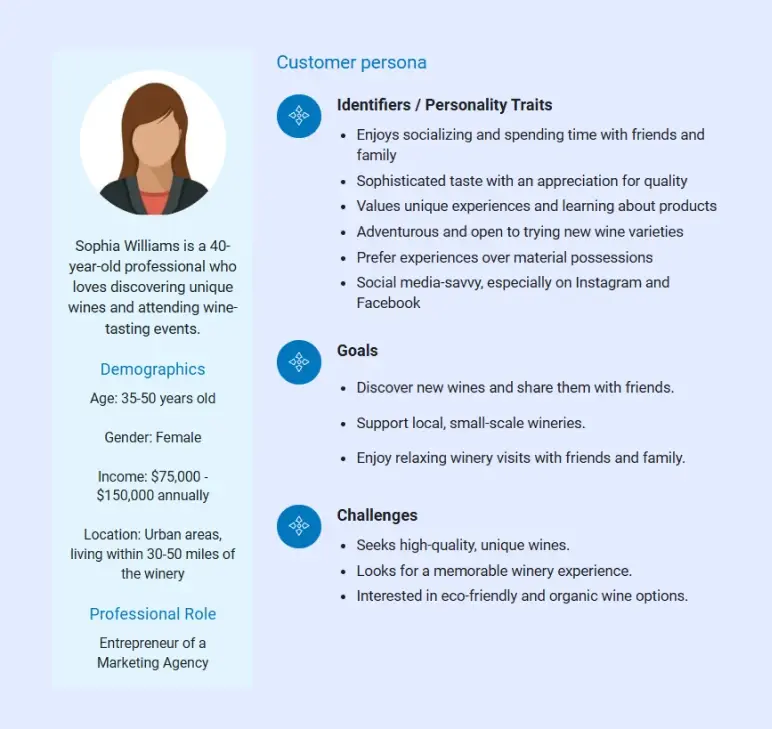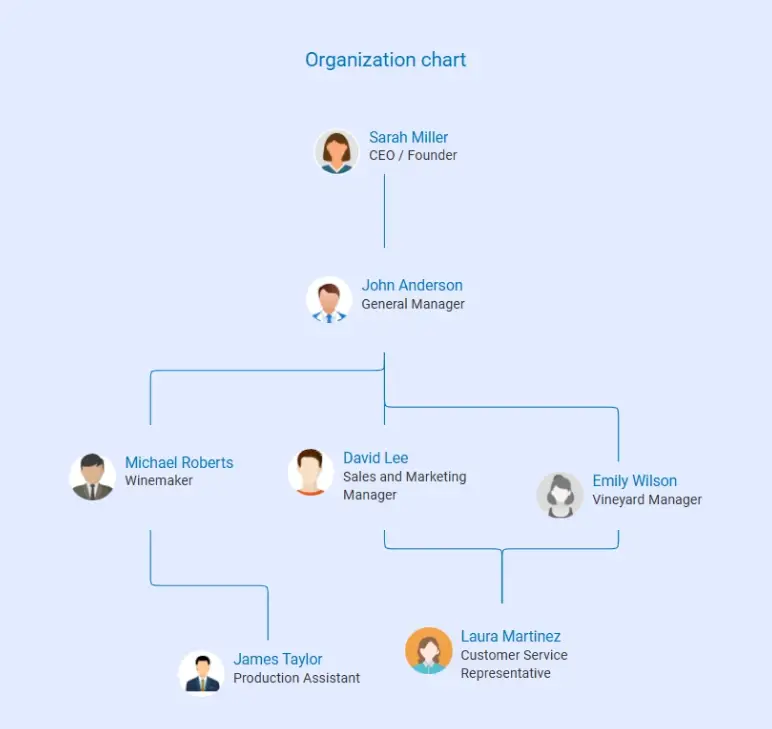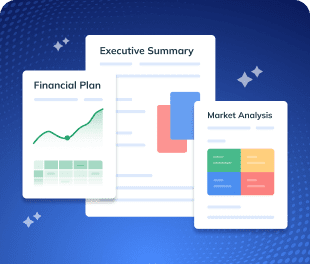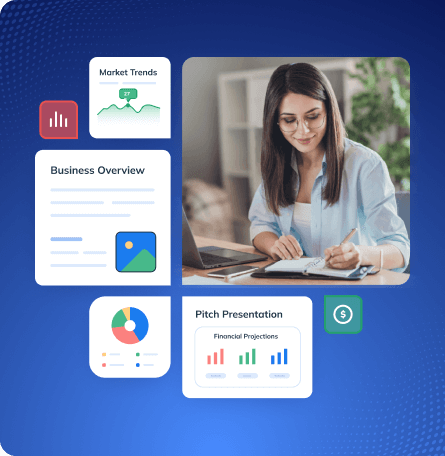Starting a winery takes more than just passion—it needs direction, structure, and vision, too.
You can’t rely on great wine alone to carry your brand. You need a plan that grounds your ideas and turns them into action.
That’s where a winery business plan comes in. A well-structured business plan helps map out everything—how you’ll grow your grapes, produce your wine, build your brand, and sell to the right people.
Wondering how to write one?
In this winery business plan template, we will give you a step-by-step guide for writing yours from scratch.
Why is a winery business plan essential?
A winery business plan helps business owners figure out how to run the winery. Here, the potential investors can get all the details—such as how you’ll produce wine, market it, manage your finances, and so much more.
A good winery business plan is also what will help you impress potential investors. Think of it as a plan of action that gives an idea about your business’s financial health and helps you make the right business decisions.
Besides, such a plan gives you the scope to be different from your competitors—as you focus on your unique story, process, and offering.
Whether you’re making it for loans, investors, or partnerships, a solid business plan is your ticket to making those connections and taking your winery to the next level.
How to draft an effective winery business plan?
You’re probably wondering how to start writing your business plan, right? Well, don’t worry. Here’s a step-by-step guide to drafting a winery business plan:
1. Executive Summary
An executive summary is a high-level overview of your complete winery business plan. Although it’s the initial component of your plan, it should be written only after you’ve written all the other components because it summarizes all the information of your business plan.
Since this is the first section that possible investors may read before they decide to proceed, be sure to make it interesting and informative but brief.
Here’s the information you need to include in this section:
- Business name, location, and type: Introduce your winery and mention where it’s located. Be clear about your business model here.
- Mission and vision: Sum up the main purpose along with your winery’s long-term vision. Your mission should specifically reflect your values, and the vision should state your aim.
- Market potential and target audience: Talk about your ideal customer demographics and keep the focus on how your wine offerings meet an existing market need or trend.
- Financial snapshot: Give an overview of your financial projections and summarize your cost estimates and planned income streams.
- Funding request (if any): Specify the required amount of your funding request and mention what type of investments you’re looking for and how you’ll allocate it to your business.
While there is a lot of information to add in this part, do not take up more than one page to write this. Readers just want the gist of your whole plan here.
Say goodbye to boring templates
Build your business plan faster and easier with AI
Plans starting from $14/month

2. Business Overview
This section offers an in-depth understanding of your winery business. It includes the foundational components of your business.
To draft this section effectively, you need to first outline the winery’s primary details.
This includes the business name, its legal structure, location, winery type, and business model.
Once you’ve done that, share a glimpse of your wine business’s background story. Like, how did you get the idea, or maybe talk a bit about what inspired you? This is your chance to build authenticity and genuine connection.
Then, go ahead and highlight your mission statement, your purpose, your values, and the client experience you aim to deliver in the coming years.
If applicable, mention the key milestones you plan to achieve and the ones you’ve achieved so far.
These elements give readers—especially investors and partners—a strong foundational understanding of who you are, what you do, and where you’re headed.
3. Market Analysis
To ensure you have a great winery business plan, you need to conduct a thorough market analysis. This will help you gain valuable insights into the external wine industry, along with the specific market niche, target audience, market trends, and primary competitors.
While drafting this section, answer the following kinds of questions:
What’s currently happening in the wine industry?
First, analyze the current trends in the wine industry. Try to answer: What are the major shifts happening?
How big is the size of the wine market? Is it growing or declining?
Provide a clear understanding of the wine market’s size.
- Is the wine industry expanding or shrinking?
- How much revenue is being generated in the market?
- Is there a particular region or wine type that is seeing significant growth?
Who’s your target audience?
Identify your target customers, including their demographic and psychographic details.

Who else is running a similar type of wine business?
Try to find out who your competitors are in the industry, be it local or regional. Also, assess:
- What are your competitors doing well?
- Are they offering a superior product, experience, or customer service?
- Where are your competitors failing to meet wine market demands?
- Is there a gap in their offerings or customer engagement that you can fill?
Once you’ve analyzed the wine market, identify where there are gaps. By identifying these gaps, you can create targeted strategies to meet customer needs.
4. Products and Services Offered
This section outlines the core products and experiences your winery business offers. It helps define your business model and highlights what makes your offerings appealing and relevant in today’s wine market.
The major takeaway for your readers here is what you’ll sell and how that will contribute to your business’s overall revenue.
You may include one or more of the following in this section:
- Retail wine sales through your tasting room, online store, or third-party distributors
- On-site wine tastings and vineyard tours
- Membership-based wine clubs or seasonal subscriptions
- Private event hosting or curated wine experiences
- Branded merchandise and gift bundles
You can also mention future offerings, such as virtual tastings, food-pairing events, or export plans.
5. Sales and Marketing Strategy
Writing the sales and marketing plan section means outlining the key approaches the winery will use to attract new customers and retain existing ones.
This section focuses on both short-term growth and long-term sustainability through practical, experience-driven strategies.
To effectively communicate the winery’s go-to marketing strategy, include the following components:
Unique Selling Proposition (USP)
These could be your sustainable farming practices, small-batch artisan wines, the scenic vineyard experience, or your winemaker’s unique style.
It’s the reason wine lovers will choose your label over another. This will help you stand out in a competitive wine market.
Pricing Strategy
Describe how you plan to price your wines in a way that reflects their quality while staying appealing to your target audience.
You might offer tiered pricing for limited editions, tasting room exclusives, or wine club memberships to serve both casual sippers and serious collectors. For instance:
| Category | When It’s Useful |
|---|---|
| Premium Pricing | For reserve wines, estate blends, or aged collections |
| Introductory Pricing | During new product launches or to enter a new market |
| Freemium or Trial | Great for tasting rooms or wine festivals |
| Loyalty Pricing | To reward and retain your best customers |
| Buy One, Get One (BOGO) | To boost volume and clear stock |
| Limited Edition Wines | To target collectors, create urgency, and boost brand value |
| Wine Club Memberships | To build recurring revenue and long-term loyalty |
Marketing Channels
Focus on reaching customers at moments when they’re exploring wine experiences or planning visits. Use platforms like Instagram and Facebook to showcase vineyard stories, behind-the-scenes moments, and upcoming events.
Optimize your website for local SEO and list your winery on travel and wine tourism directories like TripAdvisor.
Customer Retention
Offer referral discounts to tap into word-of-mouth and keep your brand top of mind. Make it easy for satisfied guests to leave reviews, and encourage repeat visits through wine club perks, email newsletters, and invitation-only events.
In addition to these aspects, you can add additional information here, like your marketing budget or, say, the type of influencers you’ll be working with. The more relevant information you can add here, the better.
6. Management Team and Organization
As its title suggests, this section presents the key people responsible for running your winery and making it thrive. This segment should show how you’ll grow your team and handle operations down the road, even if you’re kicking off solo.
Talk about how you plan to keep an eye on every part of the business as it gets bigger, whether you’re starting with a small crew or aiming to fill important roles.
If you’re thinking about working with outside advisors or mentors, you should also talk about them here. People who know a lot about wine, marketing, distribution, or money can give you helpful tips and advice as you deal with the tricky parts of running a winery.
You can also consider including an organizational chart like the one below that clearly outlines the hierarchical structure of your winery and how the team is interconnected.

7. Operations Plan
Your business operations plan shows how your winery will work behind the scenes. The goal behind this part of the plan is to let the investors know how your company functions every day.
Explaining it right not only impresses your potential investors but also adds to your credibility as a founder, capable of smooth functioning and management.
When you’re working on this part, think about including these details:
Daily Operations
Describe how you will manage the day-to-day operations, such as vineyard care, grape cultivation, and harvest. Though this is the basic part of your plan, it’ll set the foundation for the rest.
Wine Handling & Storage
Talk about how you will track and store the wine and ensure proper organization and quality control. Also, highlight how you’ll manage temperature controls and humidity and preserve the quality.
Winery Maintenance
Outline the regular facility maintenance that is required to ensure all the facilities remain functional, clean, and safe to use.
Distribution and Shipping
Describe your distribution strategy for getting wine to customers, including direct-to-customer shipping and wholesaling to retailers.
Staffing and Coordination
Mention the roles of your staff and how you will manage scheduling, tasks, delegation, and coordination between the various departments.
When you incorporate these aspects in your operations plan, this shows potential lenders and investors that you’ve thought through all the operational intricacies and created a solid strategy for smooth operations.
8. Financial Plan
The financial plan outlines how your winery will generate revenue and at what point it will become profitable. If you’re looking for funding, this is the place to mention your requirements, along with how you plan to use it.
It gives potential investors the clarity they need to evaluate whether your business is financially viable and worth supporting.
To make this section solid and investor-ready, include the following key elements:
- Startup costs
- Sales and revenue projections
- Operating expenses
- Income statement
- Cash flow statement
- Balance sheet
- Break-even analysis
Furthermore, you can add a risk mitigation strategy here to show potential investors that you’ve thought through the upcoming challenges your winery might face.
For a better understanding, you can explore these financial statements to create your own:
Income Statement
| Item | Year 1 | Year 2 | Year 3 |
|---|---|---|---|
| Revenue | 500,000 | 600,000 | 700,000 |
| Cost of Goods Sold (COGS) | 200,000 | 220,000 | 250,000 |
| Gross Profit | 300,000 | 380,000 | 450,000 |
| Operating Expenses | 100,000 | 120,000 | 140,000 |
| Sales & Marketing | 50,000 | 60,000 | 70,000 |
| Labor Costs | 40,000 | 45,000 | 50,000 |
| General & Administrative | 30,000 | 35,000 | 40,000 |
| EBITDA | 200,000 | 260,000 | 310,000 |
| Depreciation | 10,000 | 12,000 | 14,000 |
| Interest Expense | 5,000 | 6,000 | 7,000 |
| Net Income Before Tax | 185,000 | 242,000 | 289,000 |
| Income Tax Expense (20%) | 37,000 | 48,400 | 57,800 |
| Net Income | 148,000 | 193,600 | 231,200 |
Cash Flow Statement
| Item | Year 1 | Year 2 | Year 3 |
|---|---|---|---|
| Operating Activities | |||
| Net Income | 148,000 | 193,600 | 231,200 |
| Depreciation | 10,000 | 12,000 | 14,000 |
| – Accounts Receivable | -10,000 | -12,000 | -15,000 |
| – Inventory | -15,000 | -18,000 | -20,000 |
| – Accounts Payable | 5,000 | 6,000 | 7,000 |
| Net Cash from Operating Activities | 138,000 | 181,600 | 217,200 |
| Investing Activities | |||
| Purchase of Equipment | -50,000 | -60,000 | -70,000 |
| Purchase of Vineyard Land | -100,000 | -120,000 | -140,000 |
| Net Cash from Investing Activities | -150,000 | -180,000 | -210,000 |
| Financing Activities | |||
| New Equity Investment | 100,000 | 120,000 | 150,000 |
| Loan Proceeds | 50,000 | 60,000 | 70,000 |
| Loan Repayments | -20,000 | -25,000 | -30,000 |
| Net Cash from Financing Activities | 130,000 | 155,000 | 190,000 |
| Net Increase in Cash | 118,000 | 156,600 | 197,200 |
| Beginning Cash Balance | 50,000 | 168,000 | 324,600 |
| Ending Cash Balance | 168,000 | 324,600 | 521,800 |
9. Appendix
The appendix section gives you the scope to add extra information that supports your winery business plan. It’s a great way to add depth to your plan without boring readers.
It gives readers a scope to explore supporting documents and reinforces the credibility of your plan.
In this section, try to include the following documents for more clarity:
- Legal documents
- Contracts or agreement copies
- Resumes of executive team members
- Sample marketing materials
- Client testimonials or case studies
- Past financial statements or tax returns
This part doesn’t require a detailed review, but adding it might boost your plan’s credibility as a founder.
Download a free winery business plan template
Need help writing your winery business plan from scratch? Worry not! Here you go; download our free winery business plan PDF to get started.
It’s a modern business plan template specifically designed for your winery business. Use it as a guide while writing your own plan. Plus, you can customize it to match your winery’s unique needs and goals.
The Quickest Way to turn a Business Idea into a Business Plan
Fill-in-the-blanks and automatic financials make it easy.
Conclusion
You now have a detailed framework for creating your winery business plan, along with the essential components to help you build a strong foundation for success.
With this structure in place, taking your winery concept from idea to reality should feel more attainable.
However, if you’re looking to save time or need a more efficient way to create a polished, professional business plan, consider using Upmetrics. It’s an intuitive platform that leverages AI to help you generate customized business plans in just minutes.
So, wait no longer; start planning now!



